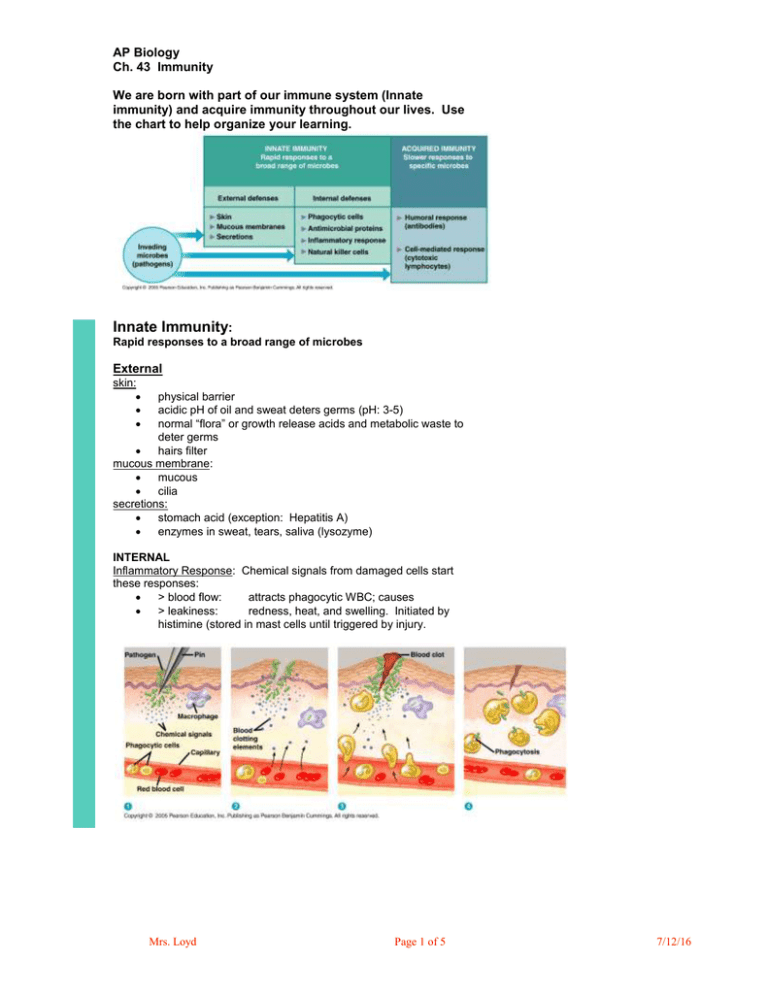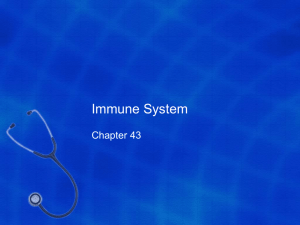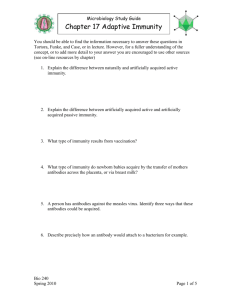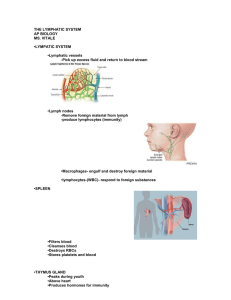AP Biology Ch. 43 Immunity
advertisement

AP Biology Ch. 43 Immunity We are born with part of our immune system (Innate immunity) and acquire immunity throughout our lives. Use the chart to help organize your learning. Innate Immunity: Rapid responses to a broad range of microbes External skin: physical barrier acidic pH of oil and sweat deters germs (pH: 3-5) normal “flora” or growth release acids and metabolic waste to deter germs hairs filter mucous membrane: mucous cilia secretions: stomach acid (exception: Hepatitis A) enzymes in sweat, tears, saliva (lysozyme) INTERNAL Inflammatory Response: Chemical signals from damaged cells start these responses: > blood flow: attracts phagocytic WBC; causes > leakiness: redness, heat, and swelling. Initiated by histimine (stored in mast cells until triggered by injury. Mrs. Loyd Page 1 of 5 7/12/16 Internal Lymphatic System: A network of fluid-collecting vessels and organs, including the lymph nodes that fight infection. Consists of: adenoids, tonsils lymph nodes spleen Peyer’s Patches’ on intestines appendix p901 Phagocytic cells: Natural Killer (NK) Cells WBC: Phagocytes: macrophages-phagocytosis cause lysis of invaders Antimicrobial Proteins complement: 30 serum proteins naturally attack microbes directly or by impeding reproduction (lysozyme). interferon: natural defense against viral infections defensins: secreted by activated macrophages Mrs. Loyd Page 2 of 5 7/12/16 ACQUIRED IMMUNITY Slower responses to specific microbes Most pathogens (invaders) are destroyed by phagocytes (nonspecific) but are tagged as “non-self” by the binding of antibodies (specific). THE IMMUNE SYSTEM Immune system: Main line of defense Recognizes “self” from “non-self.” System must be primed by presence of antigen to work. Defensive cells and antibodies are specific for an antigen. Definitions: Antigen: foreign substance (antibody generating) Antibody: specific defense protein Immunity: ability of system to “remember” previous antigens and respond promptly on the next exposure. Active Immunity: antibodies enter naturally or artificially. Body produces antibodies in its own defense. Passive Immunity: antibodies intro. From outside Temporary Immunity (few weeks>months) Ex. Mother > placenta > baby Ex. Antibody injections for traveling. THE IMMUNE RESPONSE Acquired Immunity Lymphocytes carry out the immune response The immune response is used when pathogens get past the first line of defense. It takes several days after invasion before the immune response is activated. B-cells provide the humoral immune response. B-cells are the main killers, attacking the enemy most directly. They secrete antibodies, proteins that attack foreign antigens in body fluids. T-cells provide the cell-mediated response. They attack infected body cells or stimulate defense by other cells. Long-term immunity results from the memories of enemies held by certain T-cells and B-cells. Mrs. Loyd Page 3 of 5 7/12/16 Antibodies The structure of an antibody enables it to recognize and bind to a certain antigen and trigger its destruction. (abbrev: Ig) Antigens activate only lymphocytes with complementary receptors, a process called clonal selection. In the primary response (see figure) the selected lymphocytes multiply into clones of effector cells and memory cells. Memory cells mount a rapid secondary immune response upon subsequent exposures. Helper T cells and cytotoxic T cells are the main effectors of the cell-mediated immune response. When a helper T cell encounters an antigen-presenting cell, it releases signals that activate itself and cytotoxic T cells and help to stimulate B cells. Cytotoxic T cells attack infected body cells that display foreign antigens attached to self proteins. Mrs. Loyd Page 4 of 5 7/12/16 Immune System Failure Cancer is uncontrolled cell division. The immune system normally destroys cancer cells before they spread. HIV causes the immune system to fail by invading and destroying helper T-cells and macrophages. HIV and AIDS (6:51min) Autoimmune and immunodeficiency diseases result when the immune system turns against some of the body’s own molecules. example: Lupus, Hemolytic Anemia Allergies are hypersensitive responses to antigens (allergens) that produce uncomfortable inflammatory responses. anaphylactic shock: a whole-body, life-threatening reaction that can occur within seconds of exposure to an allergen. examples: people extremely sensitivity to: bee venom, penicillin, peanuts, fish, spider bites Death may occur within a few minutes Individuals with known hypersensitivity carry syringes containing the hormone epinephrine, which counteracts this allergic response. 1. IgE antibodies produced in response to initial exposure to an allergen bind to receptors on mast cells. Mrs. Loyd 2. On subsequent exposure to the same allergen, IgE molecules attached to a mast cell recognize and bind the allergen. 3. Degranulation of the cell, triggered by cross-linking of adjacent IgE molecules, releases histamine and other chemical, leading to allergy symptoms. Page 5 of 5 7/12/16




